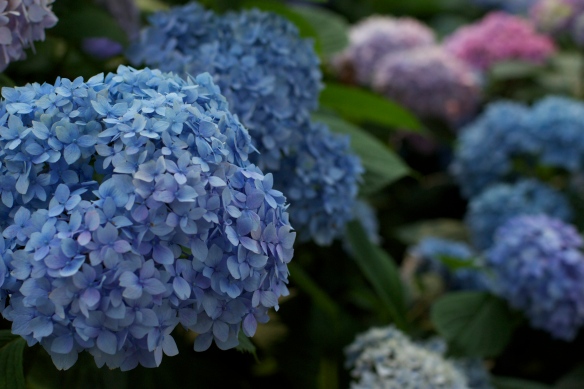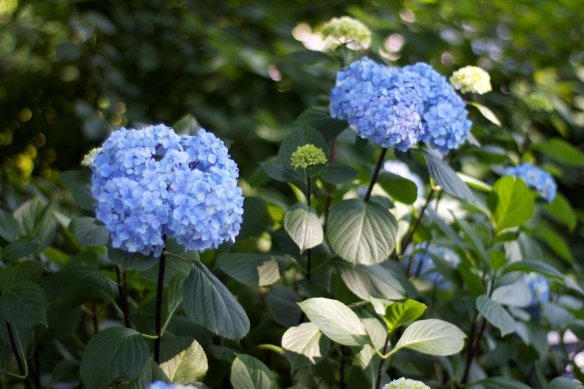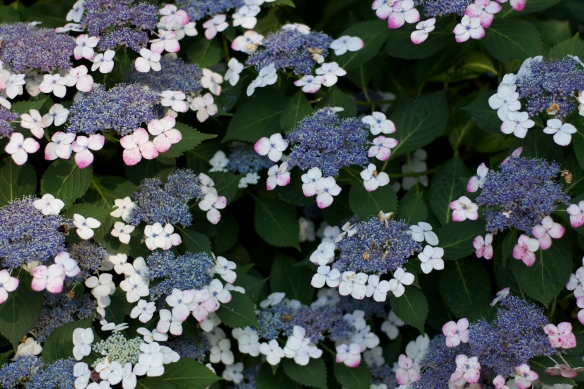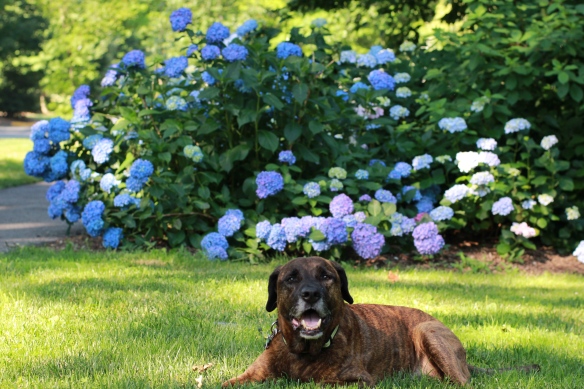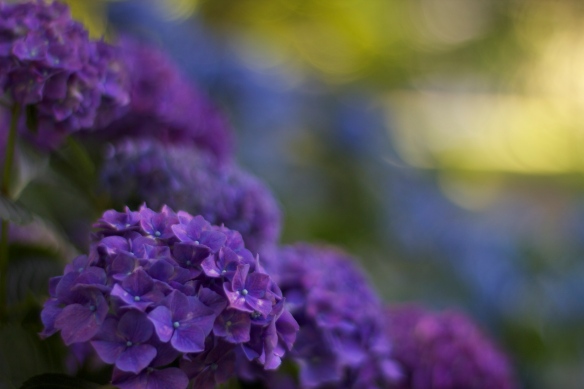“Go beyond traditional bridal bouquets and expand your repertoire to the cutting edge,” promises the Longwood Continuing Education Course Catalog when describing Unbridled Bouquets. Today’s class is another taught by Jane Godshalk (and I realize it may seem like I’m stalking her, but she just happens to be a great teacher and one of the main floral instructors at Longwood, okay?) All materials including containers are covered in the fee for this class, but we were told to bring wire cutters, a stapler, and a box to bring our stuff home in.

Students including Delphine from Belgium prep carnations for bouquet making. I'm thinking, 'carnations, boring,' but wait til you see what we made!!
There are design basics to cover in any bouquet, but since I’ve never created any type of bouquet other than hand-tied ones at the shop, I’m a clean slate for learning. First, consider what type of style you’d like: Decorative, Vegetative, or Form and Line. Your typical bridal bouquet of tightly packed white roses would be considered Decorative, it’s controlled and uses a mass of materials. Something that’s more naturalistic, with a variety of material and height is Vegetative. And then Form and Line will use less material, have strong lines, and be more dramatic. Most of the bouquets I like seem to be a combination of styles, but I do tend to favor the vegetative look – something fresh from the garden. At least that’s what I thought at the beginning of the class!

Decorative/Vegetative bouquet I could just die for by lovenfreshflowers.com, photo by wrenandfield.com, Aug 2011 cover of Philly's Grid magazine - gridphilly.com
Think about where this bouquet is going to live: is it a bridal bouquet? Not today, people. We’re going where no bouquets have gone before, because we’re unbridled. These bouquets are for the home; these you can bring to a wedding shower, dinner party, or birthday bash that the hostess can then just plop into their own container. Good idea, no?
Bouquet elements to consider:
- Balance: Symmetrical or Asymmetrical
- Binding Point: it’s either high, medium, or low.
- Stem Placement: stem can be arranged in a Radial/Spiral pattern, in a Parallel fashion, or in an Alternate pattern.
- Flower Level: flowers are all on the same plane, or they are varied from a little to a lot.
- Open or closed: flowers form a ring that’s open in the center, or entire bouquet is full. At least I think that’s what it means.
We each have a bunch of 20 carnations, which we’ve mostly removed the foliage from. Next, Jane shows us how to pierce the calyxes of each flower with wire that will connect them all together. We trade a few stems with each other here and there to get some alternate colors. (Thanks Trish!)

Piercing the carnation calyxes with copper wire

Delphine and Pat pulling their wired carnations together in hand
As we gather the wired bunches into our hands, we decide where the binding point will land. With these long stems, I’m thinking medium to high binding point. I am going radial, all the way, because I want my carnations to go in a spiral of varying heights; and then I’ll tuck stems of Dianthus ‘Green Trick’ and some pink rice flower within that spiral. But other students have done many other things with theirs. The carnations, being wired, can pretty much hold their shape exactly where you want them – imagine trying to do this with free-standing stems, how would you do it without totally losing your mind? And carnations are one of the few flowers with a big enough calyx to pierce without destroying the whole thing.

The ever-delightful Afeefa and her more open bouquet using birch branches, tied with raffia, high binding point
Then we can choose to add a little plumosus (Asparagus fern) or bear grass depending on whether we’re feeling lacy or more formal. We also have some hypericum berry we can string through if we like. Then we’ll twist the bunch with some chenille wire, adding whatever ribbon adornment we prefer.

Megan, who wants to go into event design, added bear grass threaded with purple bling to her bouquet

My carnation bouquet, thanks to Pat for taking the pic

Spiraling IN control - my bouquet at home

detail of my bouquet at home: Hypericum strung with copper wire separates carnation from Dianthus 'Green Trick'. A whole unnatural little world made of natural elements. Neat.
Next up, we create a bouquet that starts with a handful of Equisetum, cut to mostly the same length, and held together with a rubber band (which will eventually get covered up by something prettier.) The stems will be arranged in a Parallel pattern, so choose stems that are straight! Hey, did you know Equisetum is basically a living fossil? Missouri Botanical Garden says: “Equisetum is the single surviving genus of a class of primitive vascular plants that dates back to the mid-Devonian period (350 + million years ago).” It’s not a rush, or a fern, it’s in a class of it’s own, literally. Cool!

Equisetum bunched together will be the structure that holds the stems together for this lil bouquet
Then, simply pop stems inside the Equisetum structure and BAM! instant modern bouquet.

My bouquet with equisetum base (wrapped with copper wire)

My parallel bouquet from above: bear grass loops out of lisianthus, green eyed rose, ranunculus, freesia, and white allium
Here’s the next little cutie we did. In this ‘bouquet’ we threaded wire through carnations again, this time to achieve stems with an Alternating pattern. I’m sorry I didn’t get pics of what’s underneath, but I actually ended up doing most of this during lunch, since we were really packing the learning in.

My Alternate-stemmed bouquet, now on my bedside stand. Love the little green vase.
After a lunch break, we came back to find a lot of lovely colors to choose from, along with some big birch branches. Get in line for your materials and don’t be shy now!

Trish looks like a kid in a candy store!
Then we created some bouquets using Birch branches as a structure. Those of us that were doing the more Vegetative design started by created a base structure out of wire covered in brown floral tape. Wrap two 18 gauge flat wires to form a circle, and then attach four more wires to the circle, which then meet in the center under the hoop to form a sort of holder. From there, add birch branches, even binding them to the wire form to get the branches to got out horizontally.

Jane shows us the birch and wire structure technique. I'm taking notes so I didn't get too many pics of this. And the drawings in my notes are incomprehensible.
For the more modern Birch bouquet, we created a structure using “Sickles” – which are bundles of birch wrapped with wire to form little crescent shapes, or sickles. This is a technique that Jane learned from designer Gregor Lersh…who has some upcoming workshops in Germany, if you’re interested. You can make sickles out of anything that would look good bunched together – straw, bear grass, pine needles, etc.

Jane shows how to create little sickles out of birch, then shapes them into a bouquet structure, attaching them together with wire. Wire is also added to form a holder of sorts.
For both of the branch structures, greens and then flowers are simply added within the form. My hand got way tired holding all my materials in place while I created my Vegetative bouquet. Guess I’ve got to do some hand strengthening exercises!

Here, Jane adds materials to the sickle form

My completed birch bouquet in container. Very rustic.
So you see you probably could not achieve the same effect with the branches if you had just placed them into the container without foam. The wire structure made it easy to just poke stuff in, and then you hold it in place with your hand. At the end, it’s very important to finish it off with greens in order to cover the wire mechanic. Then, wire with chenille wire to wrap it all together at the end.

Jane shows us another bouquet that utilizes straws - very colorful! Great for a baby shower??
Did you think we were done yet? No, this is Unbridled Bouquets, we still have one more bouquet to make! We were at a breakneck speed at this point, and the creative juices were flowing. Jane showed us how to staple straws onto a wire, then create a structure like the birch branch one for this fun bouquet. Then poke your materials in, with hydrangea using up a lot of real estate it’s a quick one!

Stephanie's straw bouquet...cool!

Isn't the Anthurium lovely in this student's creation?
I, unfortunately, had a terrible stapler (was it made for Barbie?) whose staples were ill-fitting, so I didn’t create the straw hedgehog. Instead I wired bits of light green straw onto copper wire, which I then attached to a wire bouquet structure. I then added a bunch of Apidistra leaf (folded and stapled,) Hydrangea, Anthurium, and Dianthus ‘Green Trick’ for a little Tim-Burton-meets-Martha-Stewart action.

I'm calling this my "East Hampton" bouquet.

At home.
After a day of making bouquets (five in total!) our cheeks are flushed with productivity and pride; and maybe, just maybe, we feel a little on the unbridled side. We have boxes full of beauty to take home!

Stephanie on her way home. Hope to see you soon!
39.908889
-75.349583
 Anyway, it was so nice to be back in Jane Godshalk’s classroom, where everything is right with the world. Jane is a phenomenal teacher, and I can’t say enough lovely things about her without seeming like a gushing fool…but really. Jane does it right. Her ability to select materials that create foolproof combinations is spot on, and her directions are easy to follow and inspiring. It’s not just “boom, put it in the container, you’re done.” There is a thoughtfulness and precision to floral design; and if your materials become unwieldy, Jane will help you tame them with such a grace, you almost want to simply watch her do all the floral design. But, it is too fun not to play yourself, especially with all the Fall Bounty in front of us!
Anyway, it was so nice to be back in Jane Godshalk’s classroom, where everything is right with the world. Jane is a phenomenal teacher, and I can’t say enough lovely things about her without seeming like a gushing fool…but really. Jane does it right. Her ability to select materials that create foolproof combinations is spot on, and her directions are easy to follow and inspiring. It’s not just “boom, put it in the container, you’re done.” There is a thoughtfulness and precision to floral design; and if your materials become unwieldy, Jane will help you tame them with such a grace, you almost want to simply watch her do all the floral design. But, it is too fun not to play yourself, especially with all the Fall Bounty in front of us!



















